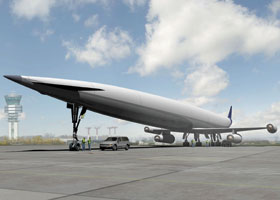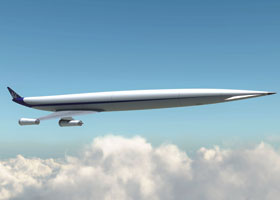Flights of the Future

The long lines will be the same. So, too, the sluggish security check-ins and navigation through tourists, crying babies and businesspeople to stow your slightly too big carry-on bag. The flight attendants will still recite their scripted safety speeches, reminding you that your seat cushion may be used as a flotation device.
But if science has its way, commercial flight will be drastically altered in the lifetime of the Millennial generation. Reaction Engines Ltd. of Oxfordshire, England, is one of the companies working on flights of the future. Its concept A2 airplane would combine extremely advanced technology with environmental friendliness. If it is ever completed, it would be an airplane that could ferry 300 people up to 12,430 miles at speeds of up to Mach 5, producing only water as an environmental byproduct.
Future flyers would be able to travel from London to Sydney in about five hours (compared to around 24 hours today)
The A2 would be one of many future airplanes powered by liquid hydrogen. Reaction Engines is developing an engine called the Scimitar that has more in common with near-future spaceship engines than modern airplane turbofans. The Scimitar would be a precooled variant of the “ramjet” supersonic propulsion system. The liquid hydrogen not only acts as a fuel source, but the super-cold fuel also works to cool the engine, which is vital at the speeds envisioned by Reaction Engines.
The comany believes the A2 is technically feasible and could be a reality within 25 years, but commercial demand will be the determining force. “Our work shows that it is possible technically; now it’s up to the world to decide if it wants it,” said Alan Bond, managing director of Reaction Engines, in a statement.

The A2 has two major selling points for success in the commercial market. First, the plane would be affordable, and a ticket would cost about as much as typical airfare. Second, even though the A2 would be 470 feet long, much larger than even the Boeing 747, it would weigh less than a typical jet airliner and still be able to land at most existing airport runways
There is one thing that passengers will have to get used to: no windows. It is neither technologically feasible nor cost effective to put airline windows in a plane that travels Mach 5. To make passengers comfortable, Reaction Engines has proposed installing digital monitors in the cabin displaying video of the world around the A2.
Hydrogen has long been known to have amazing fuel properties, but its stability has been a concern. Lockheed proposed a fast, high-altitude spy plane powered by liquid hydrogen as early as the 1950s. The Soviets experimented with liquid hydrogen as a jet fuel in the 1980s. The experimental Tupolev Tu-155 flew about 100 successful test flights in the late ’80s
Dozens of companies around the world have been working to crack the hydrogen code. If done correctly, hydrogen can be used in the A2 application (as a direct fuel source) or in fuel cells that could generate electricity to drive a propeller. The environmental benefits of hydrogen are obvious. Hydrogen only produces water and a small amount of nitrogen as byproducts, instead of a litany of pollutants and greenhouse gases let off by burning kerosene jet fuel.
Today, hydrogen-powered flight is of great interest to the military. Hydrogen has a much smaller volume than kerosene and hydrogen-powered planes can stay in the air for much longer. The Boeing Phantom Eye is under development as a long-en-durance intelligence-gathering unmanned aerial vehicle that can cruise 65,000 feet above an area of interest for up to four days at a time without being refueled. The Phantom Eye had its first flight on June 1, 2012 but is far from operational use.
The Phantom Eye is part of a larger trend of greening the U.S. military, led by the U.S. Air Force. In January, the U.S. Environmental Protection Agency placed the Air Force on its Top 25 list of Green Power Partners. The consensus is that future airplanes, including observation, fighter, bomber and cargo planes, will use hydrogen fuel.
“While Phantom Eye is important for many reasons, future [intelligence, surveillance and reconnaissance] strike and bomber programs also will benefit from the technologies we are developing and maturing for our customers,” says Darryl Davis, president of Boeing’s Phantom Works division
The Air Force more than doubled its renewable energy products in the past year to about 130 projects on 56 bases around the world, as of February. “We’ve developed a strategy we’re calling the ‘Air Force Renewable Energy Game Plan’ in which we plan to add 33 renewable energy projects on our installations during the next five years,” said Ken Gray, the chief of the Rates and Renewables Branch at the Air Force Facility Energy Center at Tyndall Air Force Base, Florida, in a statement earlier this year. “The plan would provide as much as 27% of the total Air Force electric demand in the form of renewable energy and far exceed the federal mandate of 16% renewable energy use by fiscal year 2016.”

